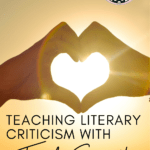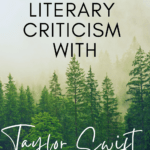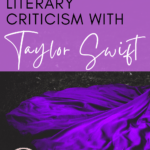I am a Taylor Swift fan. And I am also a fan of teaching literary criticism. So in honor of Women’s History Month, I’m marrying those two interests.
Literary criticism can be challenging for students. But applying critical lenses to a familiar body of work can help demystify the process.
To be clear, I do not know Taylor Swift. And she’s not affiliated with this blog in any way. However, I am both a fan and a teacher and think this is a fun way to introduce a difficult concept to students. Keep reading to learn how to teach literary criticism with Taylor Swift!

This post this post may contain affiliate links. Please read the Terms of Use.
Taylor Swift and the Basics
When I first introduce my students to literary criticism, we begin with formalism/New Criticism, biographical, and historical criticisms. These critical lenses are pretty straightforward. So students can start off with a sense of success! And this is the graphic organizer I use to help students keep track of different critical lenses. Here’s how Taylor Swift’s body of work reads through each of these lenses.
Formalism/New Criticism: Formalists seek unity in literature, analyzing how authors use literary devices, characterization, and point of view to communicate a coherent message. To find unity in Swift’s work, consider how she uses allusion to communicate the meaning of “Love Story,” “Wonderland,” or “This is Why We Can’t Have Nice Things.”
Biographical Criticism evaluates how an author’s life relates to his or her work. Every tabloid magazine following Taylor Swift’s personal life has engaged in a biographical reading of her work. Most recently, the use of home movies in the video for “Christmas Tree Farm” lends itself to biographical criticism.
Historical Criticism evaluates how a text’s historical context impacts its meaning. For example, Taylor Swift’s song “You Need to Calm Down” has been both celebrated and criticized for featuring queer icons. Similarly, some listeners consider “Miss Americana and the Heartbreak Prince” a “protest song.” Evaluating the impact of historical context on music is the job of the historical critic. Read more about introducing Historical Criticism.
Check out this resource for more information about how to introduce historical and biographical criticism.
Taylor Swift and Political Criticisms
Once my students have played with biographical and historical criticisms, we move on to the political lenses. With students, I focus on feminist and Marxist criticism.
Feminist Criticism considers how a work portrays womxn. With this literary lens, it’s interesting to consider how Swift’s image has changed since her debut. Similarly, it’s also interesting to consider how the media’s portrayal of Swift has evolved (see “Mean” for more). Within her catalogue, readers might consider how her treatment of other womxn has also evolved, moving from “You Belong with Me” to “Better than Revenge” to “Bad Blood.”
Marxist Criticism evaluates how literature relates to, represents, and exists within a capitalist system. A Marxist critic focuses on how the wealthy treat others and also in how wealth can corrupt. In other words, a Marxist is interested in privilege, which Swift comments on in the music video for “Blank Space” as well as in “The Man.”
Taylor Swift and Challenging Lenses
Finally, if students grasp previous lenses, we move into psychoanalytical, post-colonial, and deconstructionist lenses. These lenses require some prior knowledge. And these lenses do not lend themselves to every text, so, as a teacher, text selection becomes even more important.
Psychoanalytical Criticism requires some knowledge of Freud’s theories. In the realm of Taylor Swift, the lyrics for “Mine” and “Ours” provide ground for a psychoanalytical reading. Similarly, the duality of two Taylors in the music video for “…Ready for It?” fits with this lens. The makeup and costuming of “The Man” also work here.
Post-colonial criticism focuses on how colonialism exploited the countries and people it imperialized. Taylor Swift’s music video for “Wildest Dreams” has been criticized for romanticizing colonial Africa. Similarly, the video for “Shake it Off” has been criticized for cultural appropriation.
Perhaps the most challenging critical lens for students, Deconstructionism seeks to unravel a text’s unity. In fact, this is the lens that first led me to consider using Taylor Swift songs with my students. My AP Literature students were struggling to grasp an article using a Deconstructionist lens. So I turned to “Look What You Made Me Do.” This song, the first in Swift’s Reputation Era, is an anthem of empowerment. However, the phrasing of the title suggests that rather than being empowered, the speaker is being forced to act. The “you” in the title even disempowers the speaker. Exploring the deconstructionist lens through this track helped my students understand this complex lens.
“The Man” lends itself to a similar reading. In a song about female empowerment and about the consequences of male privilege, the speaker sings triumphantly about being “the man” as though that’s the best thing a person could be. In other words, the song works against itself own central message.
Epilogue
Incorporating literary criticism in the classroom is challenging. However, literary lenses help students read more critically and creatively. Let me know how you bring lit crit into your classroom!

Clipart from Monica Abarca, Andrea Riondino, Rochelle Lee, and Clipart.com.






















